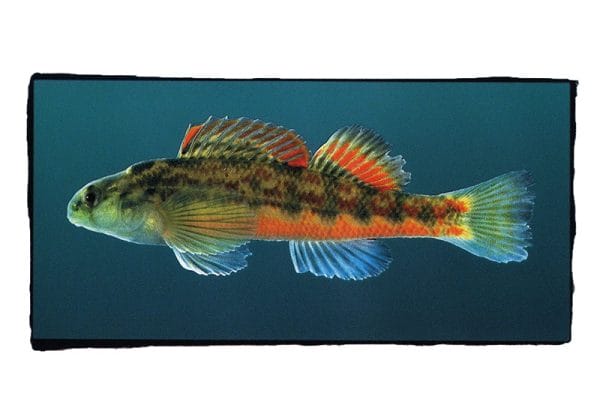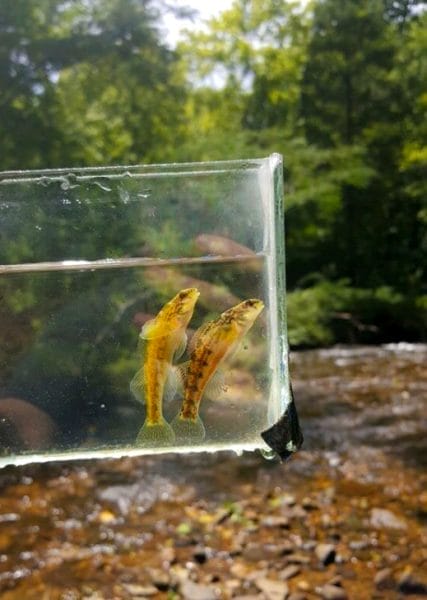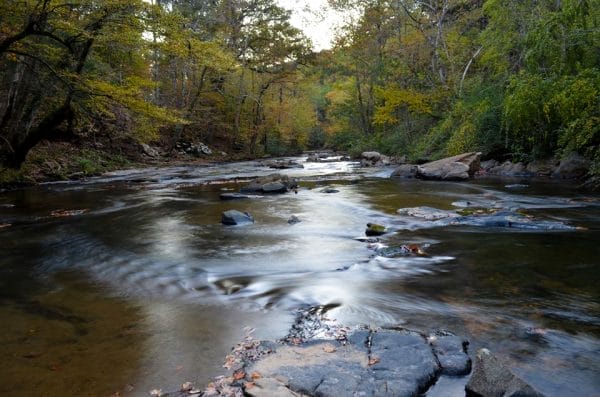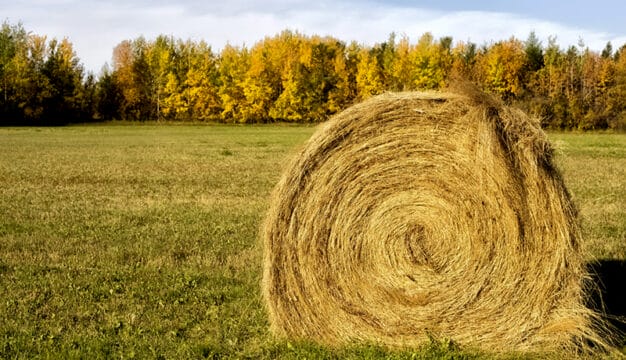Vermilion Darter
 Vermilion Darter
The vermilion darter (Etheostoma chermocki) is a species of fish in the Percidae family, which also includes economically important sport fish such as the perches, the walleye, and the sauger. Fishes in this family are characterized by having bony skeletons, fins that contain spines or rays, and some degree of armor around the head. The vermilion darter is critically endangered and is found only in the upper portion of Turkey Creek and its branches in the Black Warrior River system of Jefferson County. A portion of their habitat is located in Turkey Creek Nature Preserve, a tract managed by Birmingham-Southern College. The vermilion darter was first described in 1992 by Herbert Boschung, curator of ichthyology at the University of Alabama, and fellow biologist Richard Mayden and scientific illustrator Joseph Tomelleri in the Bulletin of the Alabama Museum of Natural History. The genus name of the vermilion darter, Etheostoma, is derived from the Greek words etheo (meaning “strain” or “filter”) and stoma (meaning “mouth”); and the specific epithet, chermocki, is in honor of Ralph L. Chermock, former director of the Environmental Geology Division at the Geological Survey of Alabama.
Vermilion Darter
The vermilion darter (Etheostoma chermocki) is a species of fish in the Percidae family, which also includes economically important sport fish such as the perches, the walleye, and the sauger. Fishes in this family are characterized by having bony skeletons, fins that contain spines or rays, and some degree of armor around the head. The vermilion darter is critically endangered and is found only in the upper portion of Turkey Creek and its branches in the Black Warrior River system of Jefferson County. A portion of their habitat is located in Turkey Creek Nature Preserve, a tract managed by Birmingham-Southern College. The vermilion darter was first described in 1992 by Herbert Boschung, curator of ichthyology at the University of Alabama, and fellow biologist Richard Mayden and scientific illustrator Joseph Tomelleri in the Bulletin of the Alabama Museum of Natural History. The genus name of the vermilion darter, Etheostoma, is derived from the Greek words etheo (meaning “strain” or “filter”) and stoma (meaning “mouth”); and the specific epithet, chermocki, is in honor of Ralph L. Chermock, former director of the Environmental Geology Division at the Geological Survey of Alabama.
The vermilion darter has a small, slender body that measures on average 1.8 to 2.5 inches (~ 4.6 to 6.4 centimeters). Adult males feature blue-tinted lower fins and a bright, reddish-orange (vermilion) scale pattern along the bottom half of their sides, for which the species was named. Females and juveniles are characterized by light olive to straw yellow bodies with eight dark stripes that extend across the spine onto either side of the fish’s body.
 Vermilion Darters
As of 2019, no comprehensive study has been conducted on the life cycle of the vermilion darter, but it is believed that the species has a life history similar to other darters in the Etheostoma genus. Fishes reach sexual maturity at about one year of age, and their physical appearance will shift beginning in January, in preparation for the upcoming breeding season that occurs from April to early May. For males, these changes include increased size of testes and brightening of scales and patterns; females also become brighter. During courtship, male darters hold their fins erect and flash their brightly colored fins and scales; if the female approves of this display, she responds by leading the male to a suitable location for spawning (or egg laying). Only one known spawning location for vermilion darters has been recorded: the juncture of Turkey Creek and the Tapawingo and Penny Springs. Female vermilion darters lay an average of 65 eggs during the season, and neither parent provides care (such as egg guarding) after the eggs have been laid. Eggs hatch about six to eight days after being laid; hatchlings and juveniles remain in the same general area as adults, feeding on tiny invertebrates (primarily immature insects). Unlike other darter species, which rarely live longer than 18 months, vermilion darters have been recorded as living up to three years of age.
Vermilion Darters
As of 2019, no comprehensive study has been conducted on the life cycle of the vermilion darter, but it is believed that the species has a life history similar to other darters in the Etheostoma genus. Fishes reach sexual maturity at about one year of age, and their physical appearance will shift beginning in January, in preparation for the upcoming breeding season that occurs from April to early May. For males, these changes include increased size of testes and brightening of scales and patterns; females also become brighter. During courtship, male darters hold their fins erect and flash their brightly colored fins and scales; if the female approves of this display, she responds by leading the male to a suitable location for spawning (or egg laying). Only one known spawning location for vermilion darters has been recorded: the juncture of Turkey Creek and the Tapawingo and Penny Springs. Female vermilion darters lay an average of 65 eggs during the season, and neither parent provides care (such as egg guarding) after the eggs have been laid. Eggs hatch about six to eight days after being laid; hatchlings and juveniles remain in the same general area as adults, feeding on tiny invertebrates (primarily immature insects). Unlike other darter species, which rarely live longer than 18 months, vermilion darters have been recorded as living up to three years of age.
The vermilion darter prefers a freshwater habitat consisting of small to medium-sized streams with bottoms of fine and coarse gravel; these streams typically feature moderate to swift currents, with just enough flow to keep the water cool and clean. Within this habitat, vermilion darters are most often found in the shallower portions along the bottom of the stream searching for prey amongst the rubble. As an omnivore, vermilion darters eat both invertebrates and plant material, but primarily focus on immature insects. Darters are typically preyed upon by larger fish and will respond to this threat by freezing—literally stopping all movement until the threat has passed. Within their ecosystems, vermilion darters fill a variety of roles that are important for maintaining the general health of the environment, such as eating insect pests and serving as prey for larger fish.
 Turkey Creek
Vermilion darters are currently under threat of extinction from a variety of sources, including pollution, development, and increased flow of sediments from runoff into their streams. These sediments bury prey and degrade water quality, as do pollutants. Pesticides from farming and lawn care are common pollutants in Turkey Creek (and a large portion of river systems across the globe), and they kill off prey animals and harm ecosystems extensively. Increasing development in Alabama’s most populous county has led to the destruction of habitat and degradation of water quality. Additionally, culverts, dams, and other barriers prevent darters from expanding their habitat.
Turkey Creek
Vermilion darters are currently under threat of extinction from a variety of sources, including pollution, development, and increased flow of sediments from runoff into their streams. These sediments bury prey and degrade water quality, as do pollutants. Pesticides from farming and lawn care are common pollutants in Turkey Creek (and a large portion of river systems across the globe), and they kill off prey animals and harm ecosystems extensively. Increasing development in Alabama’s most populous county has led to the destruction of habitat and degradation of water quality. Additionally, culverts, dams, and other barriers prevent darters from expanding their habitat.
To counter environmental threats, numerous actions have been taken, such as listing the vermilion darter as critically endangered and granting the species federally protected habitat. As of November 2001, the vermilion darter was listed as critically endangered by the U.S. Fish and Wildlife Service, but it was not until December 2010 that the species was granted approximately 13 miles of federally protected habitat in the Turkey Creek watershed. In 2013, the Old Shadow Lake Dam in Pinson was removed to restore natural water flow to Turkey Creek to protect and encourage population growth of the vermilion darter. The banks along the creek were restored and native vegetation was planted to bolster habitat health and reduce runoff. Since this restoration in 2013, vermilion darter populations have rebounded somewhat and have even been found in new portions of the creek. As biologists maintain restoration efforts, the future of vermilion darters is hopeful.
Further Reading
- Boschung, Herbert T., Richard L. Mayden, and Joseph R. Tomelleri. “Etheostoma chermocki, a New Species of Darter (Teleostei: Percidae) from the Black Warrior River Drainage of Alabama.” Bulletin of the Alabama Museum of Natural History 13 (1992):11-20.
- Boschung, Herbert T., and Richard L. Mayden. Fishes of Alabama. Washington, D.C.: Smithsonian Institution Press, 2004.
- Mettee, Maurice F., Patrick E.O’Neil, and J. Malcom Pierson. Fishes of Alabama and the Mobile Basin. Las Vegas, Nev.: Oxford House, 1996.
- Mirarchi, R. E. Alabama Wildlife. Vol. 1, A Checklist of Vertebrates and Selected Invertebrates: Aquatic Mollusks, Fishes, Amphibians, Reptiles, Birds, and Mammals. Tuscaloosa: University of Alabama Press, 2004.



